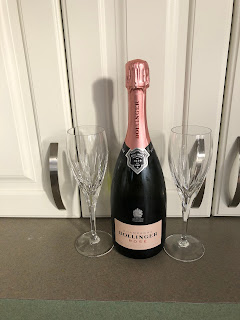For a long time now, Her Indoors and I have enjoyed a couple of glasses of sparkling wine on a Saturday evening before dinner. Often we combine this with a 'best of three' pool challenge but we haven't played for a while. This hasn't stopped us sharing a bottle of bubbles though.
Our bubbles of choice are ether Champagne or a good Méthode Traditionnelle. Champagne is first choice but not affordable every week. Méthode Traditionnelles are a bit cheaper but can be a bit of a minefield when selecting and buying them.
With European wines the safest bet is to stick with Champagne as 'non Champagne' sparklings or Méthode Traditionnelles coming from other than the Champagne region with French wines or other European countries (Italy, Spain and Germany for example) can be a bit coarse and variable.
There are some great examples of very good Méthode Traditionnelles being made in USA, Australia, England and New Zealand but the very best are prohibitively expensive (for us) and, when you are spending over $50 a bottle I'd rather stick with Champagne.
With New Zealand Méthode Traditionnelles, we've tried just about all of them (except for the most expensive) and have concluded that the best, on average, day to day, reliable brand is Deutz. We buy Deutz Rose and Deutz Blanc de Blanc on a regular basis and, when it is on deep cut special, stock up on it by the dozen-load.
When it comes to Champagne I'm on the lookout for good deals among my favourite marques but it requires a bit of caution because the sayings 'one man's meat is another man's poison' or, 'buyer beware' applies well to Champagne specials. Champagne is an expensive product being unfortunately lumped into the luxury category due to the popularity it has among rich people, socialites, celebrities and rap stars. Yes it is often (depending on the brand) over-inflated in price and represents very poor value for money (it is a 750ml bottle of 12% alcohol after all) but, with careful selection good deals can be had.
The problem with Champagne, as a luxury product, unlike its cousins shoes, handbags, boats, cars, jewellery and real estate is fragile and generally short-lived. The fragility is because it is a twice-sealed wine (look up the production method on Google) and, for NV (non vintage) Champagnes the shelf-life after disgorgement (look up Google again) is even more limited - for me, 6 months is a good measure.
I ask the retailer if I'm uncertain and I check the esoteric bottling codes printed on the bottle or label if I don't trust the retailer in order to find out when the wine was disgorged (look up Google again). I always buy Champagne that is packaged with an individual bottle carton (if buying off the shelf) or ask the retailer to take the bottle out of a case. I do this because, as I said, Champagne is delicate and long exposure to light (sunlight or fluorescent) can make the wine dull.
Anyway, we finally got through the mixed case of Champagnes that I bought back in December. This was our Christmas drinking but we managed to eke the supply out until mid March. The mix was made up of good NV, vintage, and roses (both NV and vintage). I bought them from Glengarry and again concentrated on specials. A couple of weeks ago I bought, on-line, a case of 6 of Laurent Perrier NV from Fine Wines on Line. This wine was on special and I paid $59 a bottle (down from $73).
We popped the cork on a bottle on Saturday and it was excellent - full flavoured and luscious.
The crystal glasses we use - Stuart - are of a size that we get exactly 4 glasses from a 750ml bottle. With this there is no way to cheat and sneak an extra dollop as Her Indoors will be looking for exactly two full glasses.
It's only fair.





















